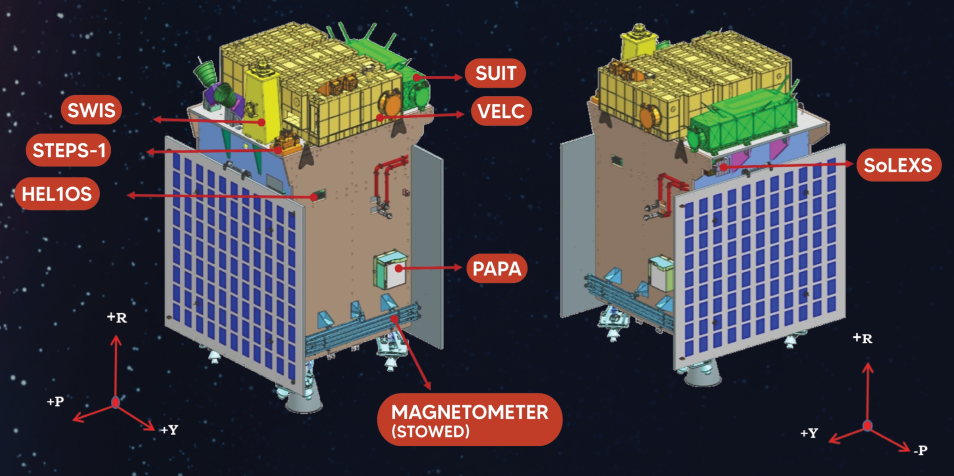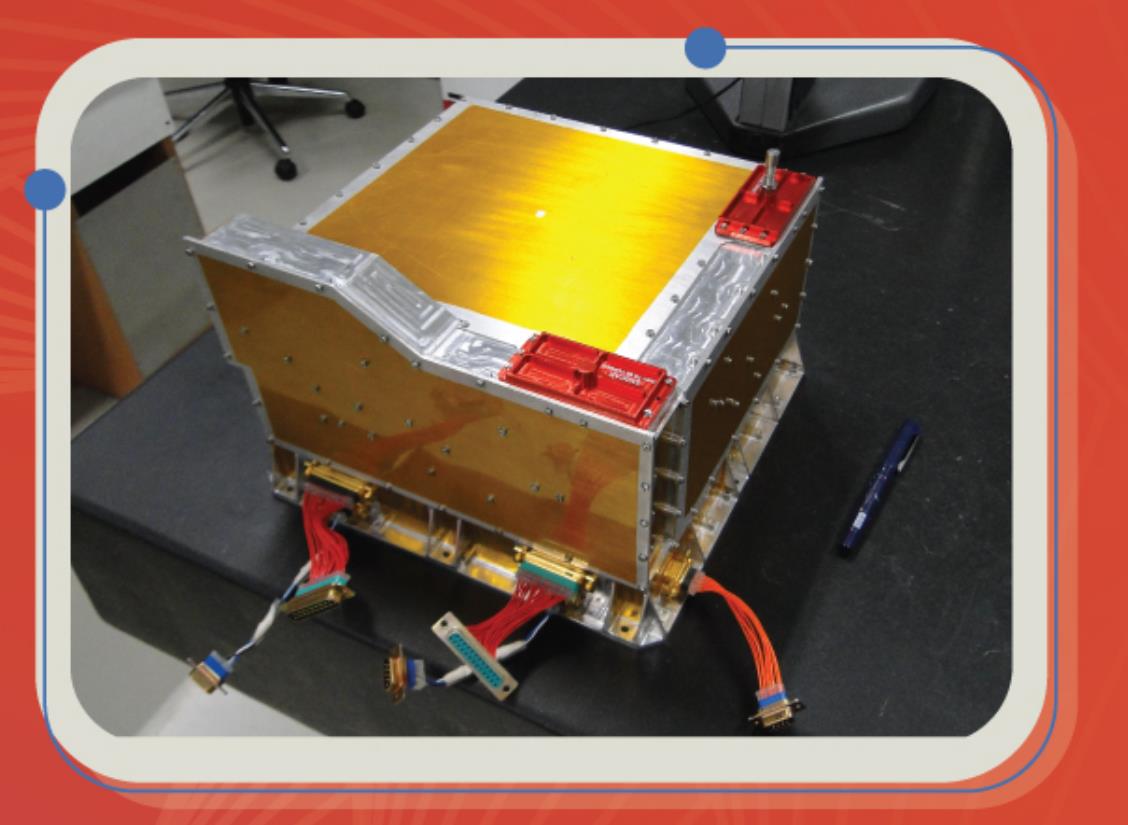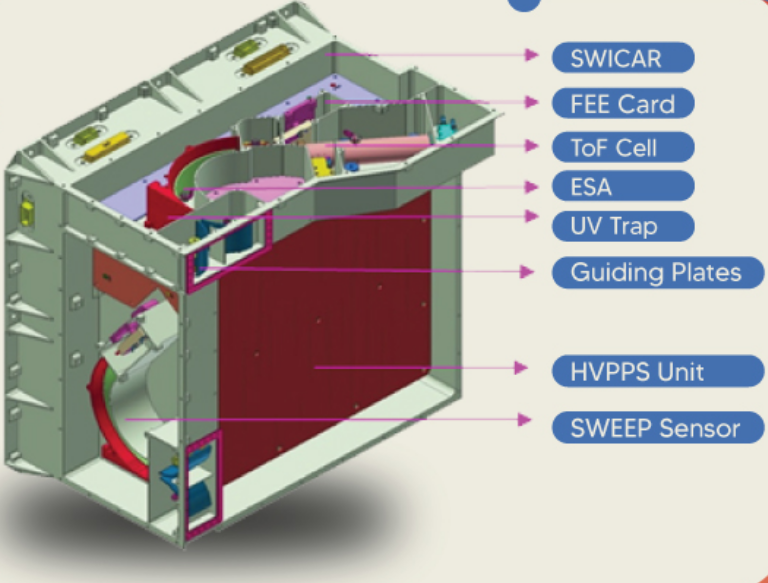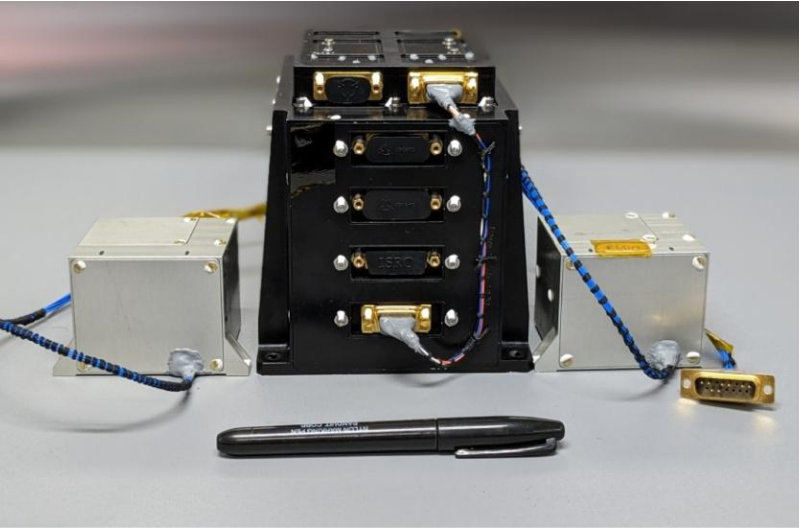Payloads aboard Aditya L1
The Sun is not just a source of light and heat; it's also a dynamic and active celestial body with a complex magnetic field and an atmosphere that extends far beyond its visible surface. Moreover, it continuously emits a stream of corpuscular radiation mainly composed of protons and electrons, known as solar wind. The solar wind plays a crucial role in shaping the space environment not only around the Earth but throughout the solar system. The transient variations in the Sun and solar wind do affect the satellites and space objects orbiting the Earth. Therefore, it has become of immense importance to understand its dynamics and monitor it continuously.
Since the beginning of the space age, there have been several satellites launched by various space agencies across the globe that have studied the Sun and ambient solar wind, and still, there are we lack a full understanding of our Star and its dynamic solar wind. In a bid to advance our understanding of the Sun and its surrounding environment,India has launched its first observatory mission, Aditya-L1. This mission is solely focused on studying the Sun from an extraordinary viewpoint: a halo orbit encircling the first Lagrangian point (L1) of the Sun-Earth system, situated about 1.5 million kilometers distant from Earth. Launched aboard ISRO's Polar Satellite Launch Vehicle (PSLV-C57), the mission seamlessly transitioned into its designated halo orbit around the L1 point on January 6, 2024. Subsequently, it commenced its observations of the Sun and the solar wind.
This mission is poised to offer continuous surveillance of the solar photosphere, chromosphere, and corona, along with monitoring solar wind and the interplanetary magnetic field at the L1 Lagrangian point. The spacecraft is equipped with seven payloads, with four of them—Solar Ultraviolet Imaging Telescope (SUIT), Visible Emission Line Coronagraph (VELC), Solar Low Energy Spectrometer (SoLEXS), and High Energy L1 Orbiting X-ray Spectrometer (HEL1OS)—directly observing the Sun. Meanwhile, the remaining three payloads—Aditya Solar Wind Particle Experiment (ASPEX), Plasma Analyser Package for Aditya (PAPA), and Magnetometer (MAG)—conduct in-situ studies of particles and the magnetic field at L1.

Figure: Stowed view of Aditya-L1 spacecraft, showing placement of all science payloads. R, P, and Y indicate the Raw, Pitch, and Roll axis of the spacecraft respectively
These payloads are anticipated to yield crucial insights into understanding coronal heating, the formation of coronal mass ejections, pre-flare and flare activities, their characteristics, and the dynamics of solar wind and space weather. The primary science goals of the Aditya-L1 mission are:
- Diagnostics of the large and small scale structures in the solar corona
- Origin and dynamics of solar flares and coronal mass ejections (CMEs)
- Solar wind composition and particle energy distribution
- Measurements of the magnitude and variability of the interplanetary magnetic field
Plasma Analyser Package for the Aditya-L1 (PAPA)

Figure: PAPA payload flight model

Figure: Schematic of PAPA payload hosting SEEP and SWICAR sensors
The Plasma Analyser Package for the Aditya-L1 (PAPA) payload is developed by Space Physics Laboratory (SPL), Vikram Sarabhai Space Centre (VSSC), ISRO. PAPA payload aims to study the composition of solar wind and its energy distributions. The payload consists of two sensors, SWEEP (Solar Wind Electron Energy Probe) and SWICAR (Solar Wind Ion Composition Analyser), mounted perpendicular to each other and with a common PAPA Processing Unit (PPU) on the same chassis. The Field of View of PAPA is 30o (elevation) X 124o (azimuth) having an angular pixel resolution of 24o X 4o. PAPA will measure electrons in energy range 0.01–3 keV and ions in 0.01–25 keV. SWEEP will exclusively measure electron parameters, while SWICAR offers two modes of operation: ion mode for measuring ion parameters and electron mode for measuring electron parameters. SWICAR will measure ion species in the mass range 1-60 amu with energies between 0.01–25 keV/q.
The main scientific objectives of PAPA are,:
- Measure solar wind electron distribution and temperature anisotropy and
- Measure solar wind composition and proton temperature anisotropy

Figure: Schematic of PAPA payload hosting SEEP and SWICAR sensors
The fluxgate magnetometer (MAG) is one of the seven payloads onboard the Aditya-L1 spacecraft to sample the local magnetic field environment around the first Lagrangian (L1) point. MAG is designed and developed by LEOS. Two sets of triaxial fluxgate sensors are mounted on a 6 meter long boom with one set at the tip of the boom and the other set at the center of the boom around 3 meters away from the spacecraft boom tip. The MAG payload is engineered to capture 8 vectors per second during operations, with its sensors capable of detecting magnetic field variations of approximately 1 nanotesla (nT) above the noise level within the range of ± 256 nT, which is the default operating range at the L1 point..
The main scientific objectives of MAG are,:
- Measurement of the interplanetary magnetic field (IMF) vectors at L1 point and its temporal evolution. Also, supplement particle measurements by PAPA and ASPEX
- Observing and identification of solar transient events such as CMEs at L1 point: